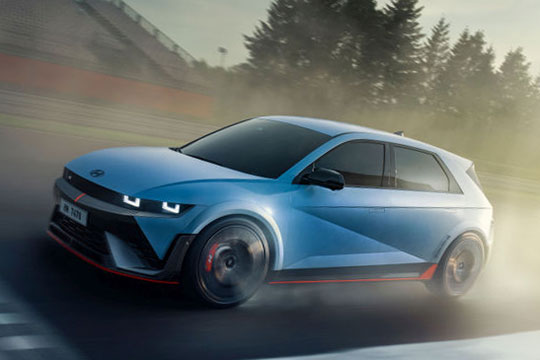HYUNDAI Ioniq 5 Models/Series Timeline, Specifications & Photos
First production year: 2023
Engines: Electric
Body style: Hatchback
Ever since Hyundai unveiled the Ioniq 5 in March 2021, the world has been surprised by the car's dynamic capabilities and the crossover stance that helped it gain the hearts and the wallets of many customers. Moreover, it looked like a concept car, which was unusual, especially for the Korean automaker. But its ideas paid off, and the car sold in huge numbers. Moreover, its E-GMP platform shared with the Kia EV6 GT was a promise that the Ioniq could get a more powerful drivetrain setup. And that happened to the car in July 2023, when Hyundai unveiled the N version of the Ioniq 5 at the Goodwood Festival of Speed.
At first sight, it looked just like a regular Ioniq 5 with some stickers on it. And yet, there were major differences in the car's exterior. At the front, a grate-like grille ran across the front fascia from side to side. It was a metallic one since Hyundai didn't want to use cheap materials for its most potent electric vehicle. Still, the automaker kept the same pixel-style headlights from the regular Ioniq 5. But the lower bumper played in a different, higher league. The automaker enhanced the car in the wind tunnel and profiled the lower chin and splitter to make the car more planted to the road. On the sides, Hyundai added flared wheel arches that covered the wider and stickier Pirelli P-Zero tires.
Furthermore, the side sills and the rear quarter panels underwent an enlargement process. As a result, the Ioniq 5 N looked sportier than its non-N sibling. Finally, at the back, the automaker placed a new bumper with an extended, integrated diffuser. Since the vehicle didn't feature any exhaust, that part was seamlessly integrated into the car's overall look.
Inside, there was enough room for five adults to travel in comfort. Still, there were some noticeable differences compared to the regular Ioniq 5. The pedals and the dead pedal sported the same pixelated design as the exterior, with checker-flag-style on the pedals and the doors' sills. Unlike the Ioniq 5, the N version featured sports seats with high-bolstered areas, offering very good side support for their occupants during high cornering speeds.
The E-GMP platform used for the Ioniq 5 and the Kia EV6 GT offered customers an all-wheel drive system with an available torque vectoring system for the rear axle. But Hyundai chose to do something else with the I5N version. It added a new 82 kWh battery under the floor, thus increasing the car's range. But the most surprising aspect of the Ioniq 5 N was under the skin, where the automaker installed a pair of motors that developed a combined power of 641 HP (650 PS), and both axles featured a torque-vectoring system, which was an improvement over the Ioniq 5 and the Kia EV6 GT.
